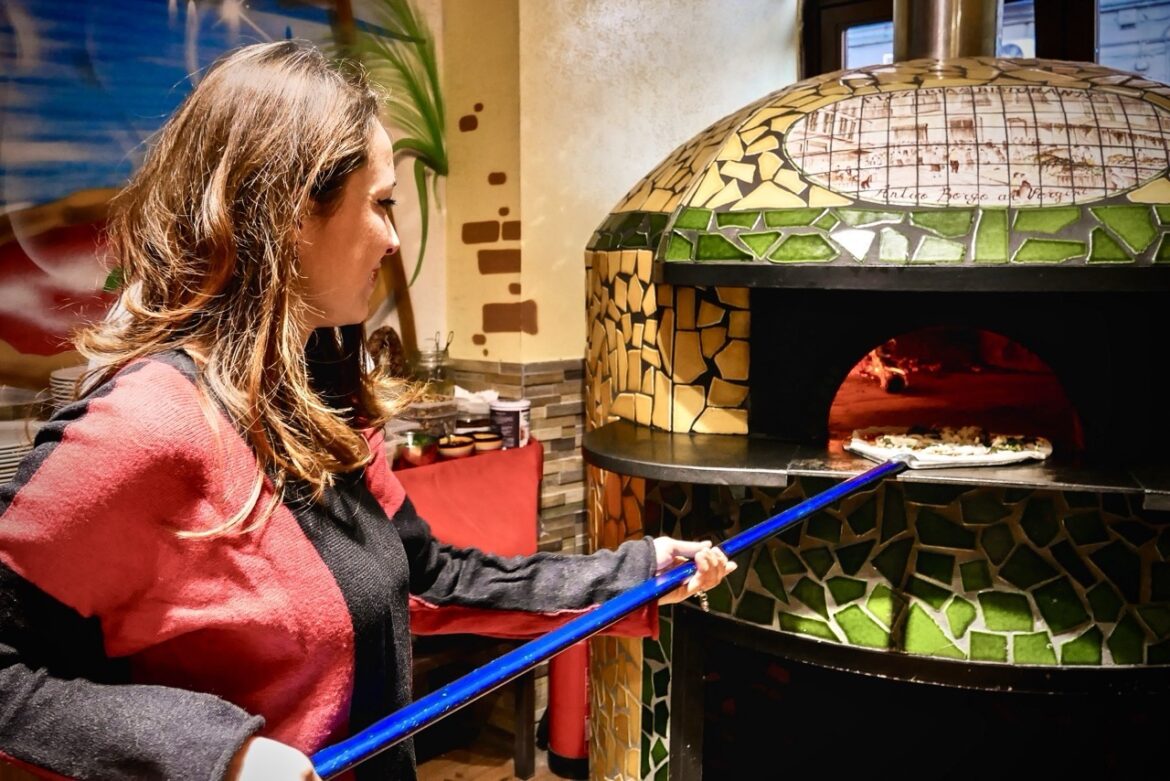Early Roots of Pizza as Humble Food in Naples Italy
Pizza’s roots in food in Naples Italy stretch back centuries, long before the classic pizzas we enjoy today. Originally, early Italians made flatbreads topped with simple, accessible ingredients—sometimes just olive oil, garlic, and herbs. These humble beginnings didn’t resemble modern pizza exactly, but they provided the foundation. The early flatbreads, called “pizzas” from the Latin pinsa meaning “flatbread,” were baked in ovens as convenient, satisfying meals for working people who needed energy-rich food on the go. Over the centuries, pizza gradually evolved with regional variations and the addition of tomatoes. By the 18th century, Naples’ port made it a prime spot for international trade, and tomatoes became widely available, forever changing the landscape of food in Naples Italy.
As these flatbreads became popular, particularly among Naples’ working class, bakers started experimenting with different toppings. Cheese, especially the locally made mozzarella di bufala, found its place on Naples’ pizzas, marking a step closer to the beloved pizzas we recognize today. These early pizzas were affordable, portable, and packed with flavor, appealing to both locals and travelers. Today, the streets of Naples still reflect these origins, with pizza stalls and pizzerias bringing the flavors and techniques of those early bakers into the modern world.
The Birth of Pizza Margherita
The creation of Pizza Margherita is legendary, solidifying its place as a symbol of Naples and Italian pride. In 1889, Queen Margherita of Savoy visited Naples, and, as the story goes, she wished to sample the local fare. Raffaele Esposito, a celebrated pizzaiolo, crafted a pizza with tomatoes, fresh mozzarella, and basil—red, white, and green to represent the Italian flag. Queen Margherita reportedly loved it, and the creation was soon named “Pizza Margherita” in her honor.
This new pizza wasn’t just delicious; it was a culinary and patriotic statement. It gained popularity throughout Naples, admired for its simplicity and vibrant flavor, which celebrated Italy’s finest ingredients. The Margherita pizza’s fame didn’t stop in Naples; it spread across Italy and eventually worldwide. Today, Pizza Margherita is celebrated as the quintessential Neapolitan pizza, embodying the values of Naples’ cuisine—freshness, flavor, and Italian pride. Each ingredient plays a distinct role, from the acidity of tomatoes grown in volcanic soil near Mount Vesuvius to the creamy, mild taste of mozzarella di bufala, capturing the essence of food in Naples Italy in every slice.
Ingredients That Define Neapolitan Pizza
The magic of Neapolitan pizza lies in its simplicity and dedication to quality. Traditional recipes focus on a few essential ingredients: finely ground flour, water, salt, and yeast for the dough. The simplicity may surprise many, but the process of kneading, proofing, and stretching the dough by hand is an art. In Naples, pizzaiolos (pizza makers) are meticulous about the dough, letting it rise for hours to achieve the soft, elastic texture that’s crucial for the finished product.
For toppings, tomatoes and mozzarella are key. The tomatoes, often San Marzano, are grown in the mineral-rich volcanic soil near Mount Vesuvius, giving them a distinct sweet, tangy flavor. Fresh mozzarella di bufala adds a creamy texture and mild taste that melts perfectly under the intense heat of a wood-fired oven. The pizza is finished with a few fresh basil leaves and a drizzle of olive oil, capturing the flavors of Italy in one bite and showcasing food in Naples Italy. Cooking at a high temperature (around 900°F) for just 60–90 seconds gives the pizza its famous lightly charred, tender crust.
Preserving Traditions for Food in Naples Italy
Locals honor traditional pizza-making methods, preserving the artistry passed down for generations. There’s a deep sense of pride in adhering to specific steps, from dough preparation to oven use, each crucial to achieving authentic Neapolitan pizza. Traditional pizzerias are meticulous about every stage of preparation, including sourcing ingredients locally, preparing dough with a specific ratio of water to flour, and allowing it to rise for a precise amount of time to develop the right texture.
In 2017, the United Nations Educational, Scientific and Cultural Organization (UNESCO) acknowledged the importance of Neapolitan pizza-making by adding it to its Intangible Cultural Heritage list. This recognition highlights not just the recipe but also the community of artisans who maintain the tradition with passion and precision. Every true Neapolitan pizzaiolo learns the techniques from experienced mentors, ensuring that each pizza meets a standard that honors Naples’ culinary heritage. UNESCO’s acknowledgment underscores Naples’ commitment to preserving these authentic techniques, keeping the spirit of traditional food in Naples Italy alive for future generations.
How Pizza Became a Global Phenomenon
Pizza’s journey from Naples to the world is a story of migration, adaptation, and universal appeal. While it originated in Naples, Italian immigrants brought the concept to the United States and beyond in the late 19th and early 20th centuries. In New York and other major cities, Neapolitan pizza quickly became popular among Italian communities and soon caught the attention of locals. Over time, American-style pizzas emerged, with variations like New York’s thin crust and Chicago’s deep dish, but the original Neapolitan pizza has always remained in demand.
In recent years, there’s been a revival of traditional Neapolitan pizza across the globe. Many chefs and food lovers have embraced authentic methods, often seeking certification from the Associazione Verace Pizza Napoletana (AVPN), an organization that upholds strict guidelines for what constitutes true Neapolitan pizza. From Tokyo to Los Angeles, pizzerias now strive to replicate the original flavors and textures that Naples perfected. This global admiration for Neapolitan pizza is a testament to its enduring appeal and the lasting impact of Naples’ food culture. Yet, for a truly authentic experience, pizza enthusiasts still flock to Naples, where every slice offers a taste of food in Naples Italy.
How to Recognize a True Neapolitan Pizza
Finding authentic Neapolitan pizza can be challenging, especially outside Naples. But in the city itself, there are a few clues to help you spot the real thing. Start with the crust: a genuine Neapolitan pizza has a soft, thin crust with slight char marks from the high heat of a wood-fired oven. This cooking method creates a distinct texture, crispy on the outside with a pillowy, airy interior. Unlike other pizza styles, Neapolitan pizza crusts are delicate and almost always foldable.
The ingredients are another giveaway. True Neapolitan pizza uses only San Marzano tomatoes and mozzarella di bufala. These tomatoes grow in the volcanic soil around Mount Vesuvius, giving them a sweet yet tangy flavor that’s hard to replicate. The mozzarella di bufala, made from buffalo milk, has a creaminess and mildness that pairs perfectly with the acidity of the tomatoes. Fresh basil and a drizzle of olive oil finish the pizza, adding a fragrant touch that’s essential to the overall experience.
If you’re still unsure, look for a certification from the Associazione Verace Pizza Napoletana (AVPN). This organization enforces strict guidelines to ensure that pizzerias follow traditional methods, from ingredient selection to cooking technique. Pizzerias that display the AVPN certification are committed to upholding the standards that make Neapolitan pizza unique. In Naples, AVPN-certified pizzerias are highly respected, drawing both locals and visitors who want the true taste of food in Naples Italy in every slice.

Highlights of the Food in Naples Italy Tour
Exploring food in Naples Italy through a guided food tour is one of the best ways to dive into the city’s culinary traditions. The Naples Food Tour takes guests through the Old Town, where you’ll discover the bustling open-air markets filled with vendors selling fresh, seasonal produce, seafood, cheeses, and more. These markets capture the daily rhythm of life in Naples, offering a firsthand look at the local ingredients that shape the city’s food scene.
As you continue into the Decumani District, you’ll experience some of Naples’ most historic streets. Known for its narrow lanes, vibrant street art, and centuries-old architecture, the Decumani area offers a glimpse into the city’s past while sampling a variety of Italian specialties. Stops on the tour include tastings of traditional Neapolitan pizza, with insights from local guides on what makes each bite special. Along the way, you’ll also sample fried snacks like zeppole (dough balls) and sfogliatella, a beloved shell-shaped pastry filled with ricotta. Each tasting provides insight into Naples’ culinary evolution, from simple street foods to artisanal treats.
The tour doesn’t just focus on food; it brings Naples’ culture and history to life. With every stop, you gain a deeper understanding of the city’s relationship with its food and the role each dish plays in local life. This immersive experience helps visitors see why Naples is a food destination unlike any other, and why Neapolitans take such pride in their cuisine. By the end, guests leave with both a full stomach and a new appreciation for the flavors and history of Naples.

Experience Food in Naples Italy!
Naples is a city that lives and breathes food, especially pizza. There’s no better way to experience this passion than by joining a Naples Food Tour. With knowledgeable local guides, you’ll taste the best of what food in Naples Italy has to offer, from the city’s famous pizzas to traditional pastries and street foods. You’ll walk away not only with delicious memories but also with a deeper understanding of why food in Naples Italy is so special. Ready to explore the flavors of Naples firsthand? Book your spot today and get ready for an unforgettable journey into the heart of Italian cuisine!



